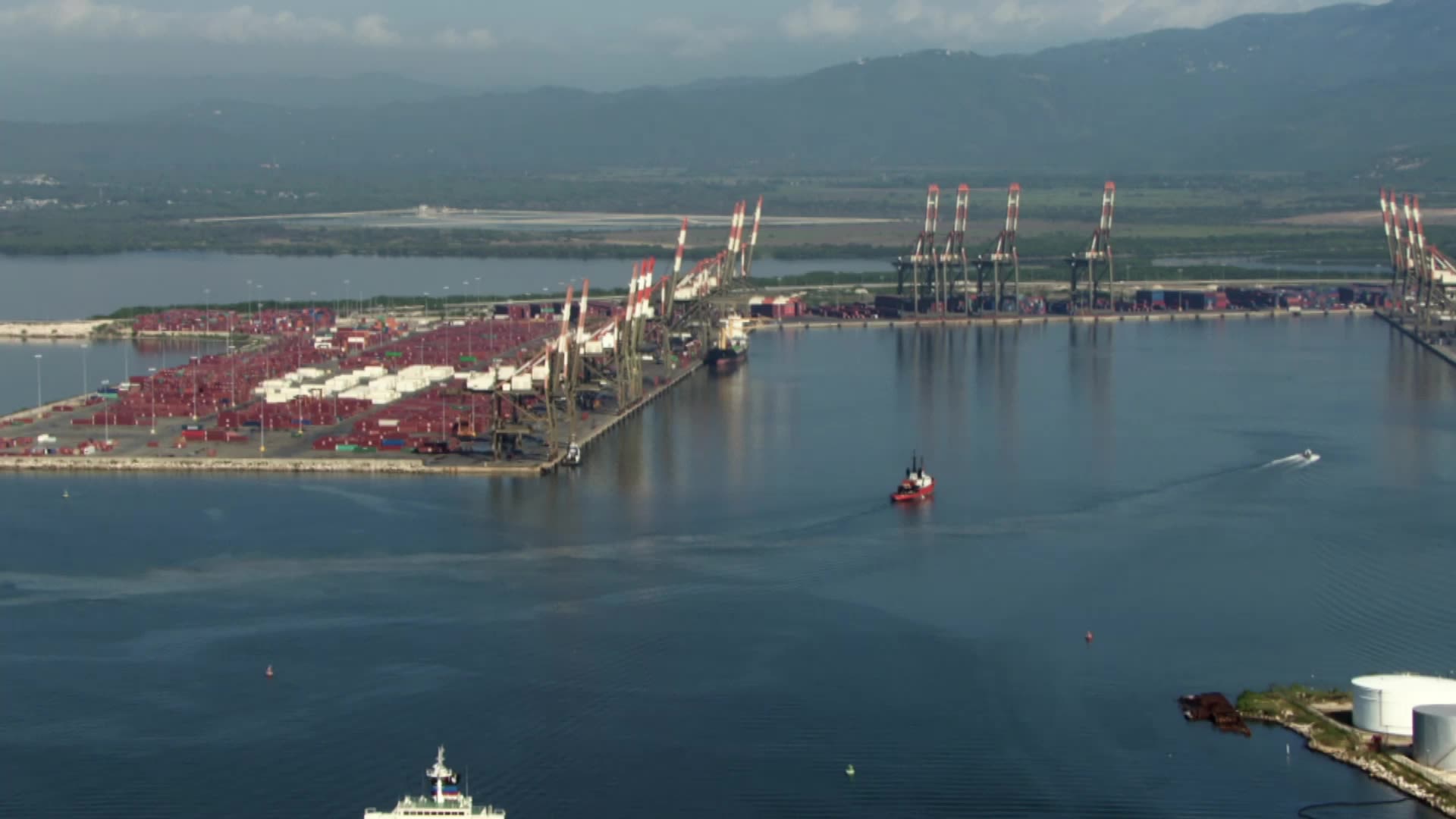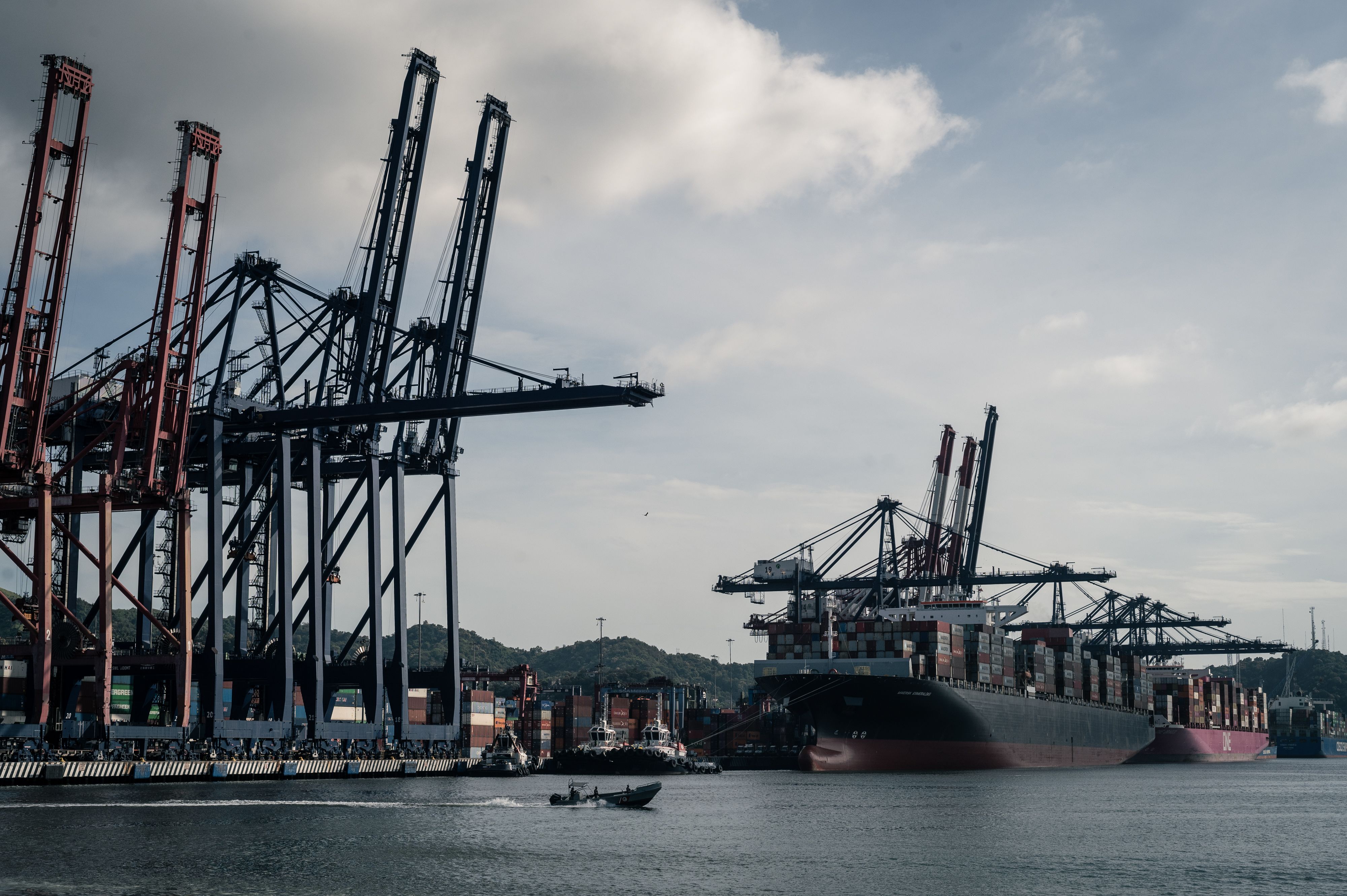No Safe Harbor
Evaluating the Risk of China's Port Projects in Latin America and the Caribbean

By: Henry Ziemer, Jaehyun Han, and Aidan Powers-Riggs
June 26, 2025
This CSIS report was jointly produced by the Americas Program and Hidden Reach.
China is rapidly expanding its influence over maritime ports across Latin America and the Caribbean (LAC). By building, financing, and buying up key ports, Chinese firms have become deeply embedded in the physical infrastructure connecting the region’s dynamic maritime economy.
While these investments bring commercial opportunity, they also open the door for Beijing to gain strategic leverage, collect sensitive data, and expand its geopolitical influence closer to U.S. shores.
Redefining Risk
Much of the alarm around China’s growing influence over global port infrastructure has focused on the Chinese navy’s push to establish overseas naval bases. In places like Djibouti and Cambodia, China first poured billions of dollars into civilian infrastructure projects before establishing military facilities—a playbook it could seek to emulate elsewhere.
Yet, the risk is far more nuanced with LAC ports. In the near term, Beijing is unlikely to overtly establish naval facilities so close to the continental United States, given the risk of blowback from Washington.
Still, gaining influence over strategic ports could provide China with critical advantages short of a formal military presence. Control or deep involvement in port operations can enable intelligence collection on U.S. and allied naval movements, privileged access to maritime logistics data, and the ability to deny or delay access during a crisis.
Recent conflicts have shown how dual-use civilian infrastructure can be repurposed for covert military operations in concerning ways. The Ukrainian military’s Operation Spider’s Web involved drones launched from shipping containers to strike targets deep within Russian territory. Israel has reportedly used similar tactics, smuggling explosive drones into Iran via commercial freight.
Containerized weapon systems, like those used in Operation Spider's Web, could be positioned within foreign-controlled port infrastructure.
Containerized weapon systems, like those used in Operation Spider's Web, could be positioned within foreign-controlled port infrastructure.
Foreign-controlled port infrastructure could serve as a platform to enable similar attacks. China has already developed a shipping container–based cruise missile launch system that could enable it to conceal strike capabilities within ordinary commercial cargo. Influence at ports could help ensure systems like these arrive where they need to be and evade inspection until they are ready to use.
Beyond military risk, control over ports also gives Chinese firms leverage over key nodes in regional supply chains, enhancing Beijing’s economic and diplomatic sway across LAC. Over time, ports can help to rewire trade relationships and solidify economic partnerships.
Risk, in this context, is best understood not as the likelihood of the establishment of a formal Chinese military base, but as the strategic vulnerability created when critical maritime infrastructure is both important to U.S. operations and subject to Chinese influence. Specifically, risk is defined as a combination of two factors:
- The extent to which the United States relies on a particular port in the LAC
- The degree to which China can accrue an advantage by influencing the operation of the port, particularly during a time of crisis on the verge of armed conflict
Building on this framework, CSIS assessed China’s involvement in LAC ports across 37 distinct projects. These projects vary significantly in nature—ranging from cofinanced infrastructure loans to full ownership and operational control by Chinese state-owned enterprises (SOEs).
Each port was scored based on 11 indicators that measure both U.S. reliance and China’s potential influence. These indicators include factors such as the host country’s diplomatic alignment, proximity to major maritime chokepoints, and whether the port is physically capable of hosting military vessels.
Indicators were also weighted by their relative importance to overall risk. Because China’s ability to exploit a port hinges most on the nature and depth of its involvement, the China influence score was weighted more heavily than U.S. exposure in the final risk calculation.
It is worth noting that the risk evaluation in this study does not attempt to predict China’s intentions. Beijing may never seek to use its influence over port infrastructure for any malign purposes. Rather, this analysis measures the potential capability China could gain through its role in port infrastructure, whether to disrupt U.S. trade, monitor naval activity, or enable coercive or covert operations in a future crisis.
While many ports pose little threat, several stand out as high risk due to their strategic location and the extent of Chinese influence. Chief among these are the Port of Kingston in Jamaica and the Mexican ports of Manzanillo and Veracruz.
Kingston
Risk Score: 70.7
The port of Kingston, Jamaica, received a score of 70.7 out of 100, making it the riskiest port in the database. The ninth-largest port in LAC by throughput, Kingston sits at the crossroads of vital Caribbean shipping routes, including U.S. commerce passing through the Panama Canal and the Mona Passage, the strait between Puerto Rico and Hispaniola. It is also the highest-ranking port operated by a Chinese SOE, granting Beijing a higher degree of control over its operations compared to privately managed facilities.
Risks associated with this port go beyond economic disruption. Jamaica plays a strategic role in the western Caribbean and is a long-standing regional security partner for the United States. China’s leverage over the largest port in a country so vital to U.S. interests in the Caribbean represents a major vulnerability.
Just 170 miles away, the presence of U.S. Naval Station Guantanamo Bay in southern Cuba means that any large-scale military activity in the Caribbean would likely involve ship movements in and around Jamaica and potentially the Port of Kingston. China’s ability to combine intelligence from this port with potential access to signals intelligence facilities in Cuba could generate valuable insights into U.S. naval operations.
The Port of Kingston is just one facet of China’s broader influence in Jamaica. China has been heavily involved in infrastructure projects across the island. In 2017, the state-owned China Harbour Engineering Company (CHEC) was awarded a $458 million contract—financed by the China Development Bank—to build the country a new highway system in exchange for exclusive rights to collect toll revenue for the next 50 years.
Manzanillo
Risk Score: 70.0
The massive port of Manzanillo on Mexico’s Pacific coast ranked second-highest in the risk index, at 70.0 out of 100. Manzanillo scores especially high in terms of U.S. exposure due to its outsized role as a hub for cargo heading to and from the United States. The spillover effects for U.S. trade from a disruption at this port could cost the U.S. economy more than $130 million a day, the most significant impact of any port in the database.
The port also serves double duty as headquarters for Mexico’s Pacific Naval Force, meaning China’s influence could also enable it to collect intelligence on Mexican military operations, including joint exercises with the United States.
China exercises influence over the port through multiple channels. First, the TIMSA port terminal is one of seven facilities operated by the Hong Kong–based holdings company CK Hutchison in LAC (including four in Mexico). Second, the People’s Bank of China, together with the Inter-American Development Bank, cofinanced a major expansion of the port in 2015. As part of the project, CHEC built a new container and logistics facility, and Shanghai Zhenhua Heavy Industries (ZPMC) supplied and installed several new cranes.
Today, Manzanillo sits at the heart of U.S.-Mexico tensions concerning China’s growing influence in the country. The China-Mexico sea route is one of the fastest-growing shipping lanes in the world. Intending to capitalize on this, Mexican President Claudia Sheinbaum has announced a new $2.7 billion investment in Manzanillo, seeking to double the size of the port.
Also of note, Manzanillo’s location in Colima state—a territory hotly contested between the Jalisco Cartel New Generation and local rivals—makes it an appealing target for organized crime. In December 2024, 25 tons of fentanyl precursors were seized at the port, the majority of them arriving from China.
Veracruz
Risk Score: 64.7
With an overall score of 64.7 out of 100, the Mexican port of Veracruz scored the third-highest in the dataset. Like Manzanillo, it hosts a Hutchison-operated terminal, and both CHEC and the U.S.-blacklisted China Communications Construction Company have helped expand the port in recent years.
Unlike Manzanillo, however, the port’s location on Mexico’s Caribbean coast orients it more toward trade with the United States than Asia. While the port is much smaller in terms of overall volume of trade, disruption at Veracruz could still cost the U.S. economy $63 million a day.
In April 2025, the Arleigh Burke-class destroyer USS Gravely docked at Veracruz following over a month patrolling the Gulf of Mexico, underscoring the port’s value to the U.S. Navy as a regional resupply hub. As U.S. naval activity in the region ramps up with the White House’s increasing attention on southwest border security missions, China may benefit from new intelligence-gathering opportunities when these ships come to port for resupply.
To Build or To Buy
Despite widespread perceptions that China has full operational control over its port investments in LAC, the reality is far more complex. Just 10 of the 37 Chinese-linked port projects identified in this study involve active facilities owned or operated by Chinese firms. The rest reflect a mix of financing, construction, or equipment supply—each with different risk implications.
Construction projects, for example, appear aligned with China’s broader economic strategy in LAC, which revolves around securing preferential access to key commodities. To this end, Chinese firms have invested in expanding Peruvian ports near key mines, Brazilian bulk grain terminals, and Venezuelan oil export sites.
These projects generally pose less direct risk than those operated by Chinese companies, but they still create long-term dependencies and relationships with host-country elites, port authorities, and customs agencies. They also create an opportunity to introduce Chinese technology at a port that could provide an intelligence back door even without a daily Chinese presence.
Equipment from Nuctech and ZPMC, for instance, has been installed in at least five ports in the database not under Chinese operational control. Similarly, in Panama’s Colón Container Terminal, Chinese state-linked telecommunications firms Huawei and ZTE—both blacklisted in the United States for their ties with China’s military—provided 300 security cameras. While the contract between Panama and Shandong’s Landbridge group was ultimately cancelled, these cameras remain in place.
Of the 10 currently active ports operated by a Chinese company, seven are managed by a single company, CK Hutchison. These include major terminals at Manzanillo, Veracruz, Balboa, and Cristóbal. Historically viewed as commercially driven and somewhat insulated from the Chinese state, Hutchison’s posture has shifted under new geopolitical pressures.
Beijing’s tightening grip on Hong Kong and the 2017 National Intelligence Law, which compels even private firms to cooperate with state intelligence efforts, have eroded assumptions about Hutchison’s independence. In several ports, Hutchison has also contracted with state-owned Chinese construction giants such as CHEC, suggesting Hutchison’s presence may pave the way for Beijing to deepen its foothold.
In 2025, Hutchison announced plans to sell 43 of its overseas ports—including all seven LAC terminals—to a consortium led by U.S.-based BlackRock for $23 billion. In response, China’s State Administration for Market Regulation launched an antitrust review that could block or delay the deal. The agreement remains on uncertain footing.
If completed, the sale could meaningfully reduce Beijing’s foothold in the region’s port infrastructure. However, there are signs that China may be using the spotlight on the Panama Canal ports to expand its broader footprint in the region. Recent reports indicate that the state-owned China Ocean Shipping Company is seeking to acquire a stake in the 43 ports currently up for sale, including key terminals in Latin America.

While China’s influence in LAC maritime infrastructure is more widespread than previously reported, the United States, alongside regional partners, can take substantive steps to minimize risk at these ports.
Support port buybacks and buyouts. Recent developments suggest there is space for market-driven efforts to dilute China’s port footprint. Policymakers should explore ways to quietly support such efforts—particularly where they align with commercial interest and strategic value.
Assess and reduce strategic exposure. The United States should continue evaluating where its logistical and military interests most intersect with foreign-controlled ports in the Western Hemisphere. A more comprehensive understanding of exposure can help guide both policy planning and future risk mitigation.
Strengthen oversight and resilience at key ports. Improving inspection protocols and increasing visibility into port operations can help reduce vulnerabilities. Quiet support to partner nations’ port authorities may offer a low-cost way to guard against surveillance, deter illicit activity, and mitigate China’s efforts to gain deeper strategic influence.
Learn about the methodology behind this report and explore the database.
This report was made possible by general support to CSIS. No direct sponsorship contributed to this report.
Written by: Henry Ziemer, Jaehyun Han, and Aidan Powers-Riggs
Special thanks to: Matthew P. Funaiole, David Peng, Brian Hart, and Ryan C. Berg
Produced by: Michael Kohler
Database development by: José Romero
Development support by: Mariel de la Garza
Copyediting support by: Phillip Meylan and Hunter Hallman
Design support by: Will Taylor
Photo/Video via Getty Images: Miguel Fernández Sitges, Aerial Filmworks, Bloomberg Video - Footage, Bloomberg, Martin Bernetti, ssu.gov.ua
